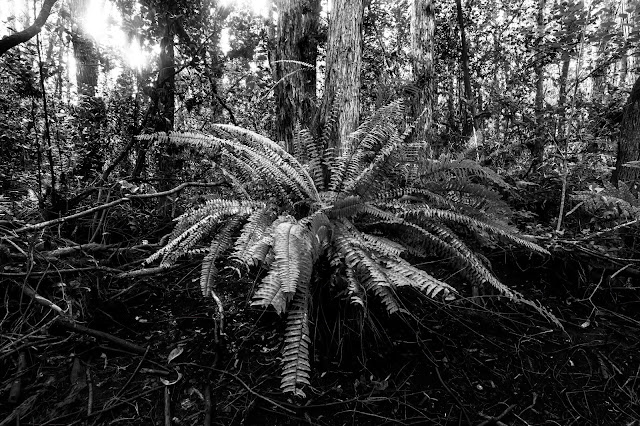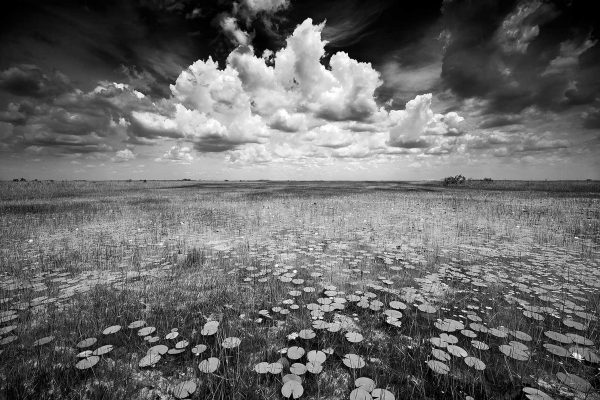We had booked an early morning walk with Clyde Butcher's organization and it was an experience. This was Scott's main reason for wanting to return to the Everglades.
 |
| Photo: Scott Stevens |
Who is Clyde Butcher?
 |
| Clyde Butcher |
Born in Kansas City, Missouri, Butcher graduated from California Polytechnic University in 1960 with a degree in architecture.
Unfortunately, he had great difficulty drawing architectural designs. So, he taught himself photography, enabling him to photograph architectural models for presentations.
 |
| Butcher with a large-format camera |
After losing his architectural job during the economic downturn in 1970, he began showing black and white images at local art festivals and realized that he could make more money in photography than he was making in architecture.
By 1970, he left architecture for landscape photography.
 |
| 1970s decor with mural |
To increase sales, Butcher started photographing with color film so his images could match the avocado green shag carpets and gold couches popular at the time. The bulk of his images at this time were taken west of the Rocky Mountains and in the Pacific Northwest.
He lived with his wife on a boat in Southern California for seven years and, then, inspired by the television show, Flipper, he moved to Florida. He sold his business in California and returned to selling art in street festivals. Much of what he sold was his color work from the west coast.
 |
| Clamshell Orchid 1 © 2003 |
After his son was killed by a drunk driver in 1986, Butcher retreated to the wilderness for solace and restoration. He returned to black-and-white landscape photography, now using large-format cameras. He actually destroyed his color work and vowed to use only black and white film.
 |
| Big Cypress National Preserve 1 © 1999 |
 |
| Clyde with his work |
 |
| Conservation 5 © 2004 |
Read the Suggestions First
Of course, we prepared for our hike completely wrong. The website suggested wearing jeans and old sneakers. Thinking we were smarter than that, we brought hip waders and Wellies to deal with the potentially deep water.
When we checked in, we were told that that was a bad idea because they could fill with water or get stuck in the thick mud we would be walking through.
 |
| The mud can grab your shoes and suck them in |
Yikes!
I had some quick-dry pants I could wear, but no sneakers that I wanted to submerge in mud.
No problem!
They had lots of pairs of old shoes we could borrow. Even though Scott had shoes with him he could wear, he opted to borrow shoes as well. That was a good idea.
I am not sure we could have ever gotten the mud out of our shoes. As it was, we threw away our socks after the walk.
Our Walk
Our guide, Scott Randolph, met us in the early morning (actually he agreed to come a half an hour early) right outside our cottage. That is when we learned that, because of COVID, it was a private tour! Just Scott and me. Sweet!
Randolph was exceptionally knowledgeable and obviously loved the swamp. He spent a lot of his free time clearing paths, which makes it easier to navigate the tangled environment.
Scott was interested in reflections and, although recent droughts had reduced water levels, Randolph found us some good vistas.
 |
| Photo: Scott Stevens |
Quite frankly, I was thankful for the drought (in this one instance). I have a friend who had done this walk when water was chest high. No thank you!
In our case, most of the walk was mid-calf or less. It was a little treacherous because you can't see the roots and holes below the surface. But, we had walking sticks and moved carefully.
 |
| Scott and me in the gear we finally decided upon |
As usual, I brought way too much gear that I didn't use. But, I managed to keep my cameras dry and get some passable shots.
It was early, so it was a bit dark and gloomy. But, had it been lighter, we would have had to struggle with light-dappling. And, toward the end of the walk, as the sun came out, it started to get very steamy.
This kind of photography is really Scott's thing; not so much mine. He was trying to capture dramatic black-and-white images, many of which I have included in this post. It's beautiful work.
 |
| Photo: Scott Stevens |
Wildlife
I, of course, was interested in wildlife. Would we see a Bear? A Panther? A Bobcat? Exotic birds?
Nope!
We heard Roseate Spoonbills, Great-crested Flycatchers and Alligators, but saw none. Randolph found an Everglades Crayfish ...
 |
| Everglades Crayfish |
And, a Striped Crayfish Snake ...
 |
| I had never hear of a Crayfish Snake (they eat Crayfish) |
It was so dark when we saw those that I am shocked that I was able to coax any images out of what I took.
I found a few myself: a lonely Brown Anole that posed for me (or was just enjoying a little patch of sun) ...
 |
| This guy never moved |
A Florida Ivory Millipede ...
 |
| Curled up on the path |
And, spider I have yet to ID ...
 |
| An Everglades spider |
Of course, there were lots of fascinating plants, including ferns ...
Air plants ...
Mosses ...
Grasses ...
Cypress trees ...
 |
| Swamp flowers |
The walk was peaceful and enjoyable – there is an otherworldly calm in the swamps.
Although I was a bit worried about poisonous snakes, we didn't have any encounters and it didn't stop me.
All in all, it was a lovely experience that produced some beautiful photos.
Oh, and staying in the cottage on property was the best idea of all. We took or muddy selves back and showered and changed without having to get in our car. That was the best!
Trip date: April 1-19, 2021












No comments:
Post a Comment